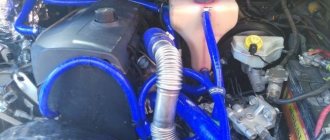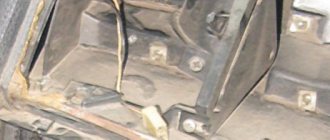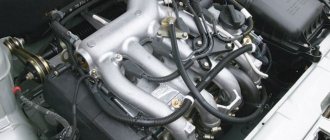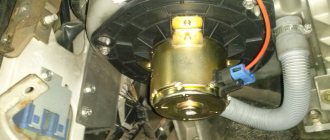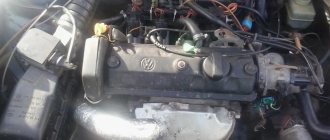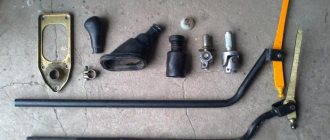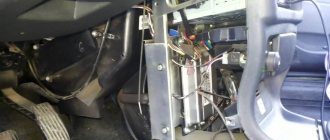On the VAZ 10th family, which includes the VAZ 2110-2112 models, the designers used an electronically controlled interior heating system, thanks to which the temperature set by the driver is maintained automatically.
On the VAZ-2110, instead of a manual heater control mechanism with a cable drive of the main elements - the coolant shut-off valve and dampers, an automatic heater control system (AHC) controller with a temperature sensor and a gearmotor that regulates the position of the dampers are used.
In such a stove, the valve for shutting off the antifreeze supply is no longer used, and the adjustment of the heater operating mode - “heating” or “ventilation” - is carried out by a central damper, which directs the air flow through the radiator or bypassing it.
How malfunctions manifest themselves
The automatic temperature maintenance system used on the VAZ-2110 is more convenient in terms of control, since the automatic control system does everything independently, but is less reliable than a mechanical cable drive. Moreover, problems are caused by the electronic and electrical components of the stove - the controller, temperature sensor and micromotor gearbox, the central damper, which regulates the air supply to the cabin from the outside.
Problems with the operation of the VAZ-2110 heater related to the damper:
- lack of temperature control (only hot or cold air comes from the stove) regardless of the position of the handle on the controller;
- insufficient air heating (even when setting the handle to the maximum temperature);
- squeaks, knocks and extraneous noises after setting the temperature.
The cause of such problems is the central damper of the VAZ-2110 stove, which is adjusted by the controller through a gearbox. The design of the stove includes another damper - air distribution into zones. It is controlled using a handle mounted on the central air supply deflector into the cabin, so malfunctions with this part are rare.
Stories from our readers
“Fucking basin. "
Hi all! My name is Mikhail, now I’ll tell you a story about how I managed to exchange my two-wheeler for a 2010 Camry. It all started with the fact that I began to be wildly irritated by the breakdowns of the two-wheeler, it seemed like nothing serious was broken, but damn it, there were so many little things that really started to irritate me. This is where the idea arose that it was time to change the car to a foreign car. The choice fell on the melting Camry of the tenth years.
Yes, I had matured morally, but financially I just couldn’t handle it. I’ll say right away that I am against loans and taking a car, especially not a new one, on credit is unreasonable. My salary is 24k a month, so collecting 600-700 thousand is almost impossible for me. I started looking for different ways to make money on the Internet. You can’t imagine how many scams there are, what I haven’t tried: sports betting, network marketing, and even the volcano casino, where I successfully lost about 10 thousand ((The only direction in which it seemed to me that I could make money was currency trading on the stock exchange, they call it Forex. But when I started delving into it, I realized that it was very difficult for me. I continued to dig further and came across binary options. The essence is the same as in Forex, but it’s much easier to understand. I started reading forums, studying trading strategies. I tried it on a demo account, then opened a real account. To be honest, I didn’t manage to start earning money right away, until I understood all the mechanics of options, I lost about 3,000 rubles, but as it turned out, it was a precious experience. Now I earn 5-7 thousand rubles a day. I managed to get the car buy after half a year, but in my opinion this is a good result, and it’s not about the car, my life has changed, I naturally quit my job, I have more free time for myself and my family. You’ll laugh, but I work directly on the phone)) If If you want to change your life like me, then here’s what I advise you to do right now: 1. Register on the site 2. Practice on a Demo account (it’s free). 3. As soon as you get something on the Demo account, top up your REAL ACCOUNT and go to REAL MONEY! I also advise you to download the application to your phone, it’s much more convenient to work from your phone. Download here.
SAUO pinout:
The SAUO receives information from:
- – cabin air temperature sensor (No. 6), which has a built-in small-sized fan.
- – MMR (micromotor reducer) (No. 9), information about the position of the heater damper.
Damper control: Based on the received information and the set air temperature, the controller controls the position of the heater damper, sending appropriate signals to the damper drive micromotor.
Features of the design of the VAZ - 2110 stove damper
Note that VAZ-2110 of different years of manufacture uses heaters that differ in design:
1. Old-style stove damper
Old heaters use two central dampers, one of which blocks the flow of air into the cabin from the outside, and the second one redirects the air flow to the heater radiator or bypasses it. They are interconnected by drives and opened by a micromotor gearbox.
2. New sample
In the new type of stove there is only one central damper and it is connected by a drive to the gear motor directly, and not through a lever.
3. Under the “Euro” panel
Structurally, such a stove does not differ from the new type of heater, but in it the damper for distributing the air flow into zones is controlled by another micromotor gearbox.
It is easy to visually distinguish the stoves by the location of the heater fan. In the old-style interior heater, the fan is located horizontally, while in the new model, it is positioned vertically. Their gearmotors are also different.
What to do if the stove in the car does not heat well
If the stove in the car does not heat well or does not work at all, then you first need to determine the cause of the malfunction and then eliminate it. Most problems with a car heater manifest themselves as follows:
- The stove in the car does not heat well;
- The heater in the car blows cold air;
- The stove in the car sometimes works, sometimes it doesn’t (it blows either cold or hot air);
- The air from the stove in the car is quite hot, but it blows weakly;
- The heater in the car does not work (does not turn on).
In the table below, we have combined the possible reasons for the malfunction of the car's interior heating system, described how they can affect the operation of the stove, and listed ways to eliminate them.
| Possible cause of stove malfunction | Symptoms of a malfunction | Remedies |
| Air in the interior heating and engine cooling system | 1. The stove does not heat well; 2. The stove blows cold air; 3. The stove blows either cold or hot air. | 1. Remove air from the system (simple method here); 2. If air is not removed or appears again, check whether the cylinder head gasket is broken. |
| Thermostat stuck open | Check the thermostat, if a malfunction is detected, replace it with a new one. | |
| Heater radiator clogged | 1. The stove does not heat well; 2. The stove blows cold air. | 1. Vacuum the surface of the radiator; 2. Flush the engine cooling system; 3. If all else fails, replace the radiator. |
| Problems with the heater valve or air damper controls | 1. Check whether the cable has come off the damper control levers or the heater tap; 2. If the heater tap is faulty, it must be replaced. | |
| Cabin filter clogged | 1. The air from the stove is quite hot, but it blows weakly. | Replace the cabin filter. |
| The fan is not blowing well | Contact a specialist (auto electrician) to determine the causes of the malfunction and eliminate them. | |
| The fan does not turn on | 1. The stove in the car does not work (does not turn on); 2. The air from the stove is quite hot, but it blows weakly and only at high speed. | |
| Problems with the stove control unit | 1. The stove does not heat well; 2. The stove blows cold air; 3. The stove blows either cold or hot air; 4. The stove does not work (does not turn on). |
If the stove heats the interior to 16 degrees from below and up to 10 degrees from above in severe frost outside, then it can be considered working. But in order to avoid unwanted problems and to warm up the car well, it is recommended to take preventive measures in a timely manner to ensure the correct operation of the heater. It should be remembered that the longer the car’s service life, the more attention its heating system requires.
Causes of malfunctions
Depending on the design of the stove, the damper may cause a disruption in the efficient operation of the heater for the following reasons:
- deformation;
- wear of seals;
- deterioration or damage to control levers and rods;
- skew.
Deformation is a problem with old-style heaters. The first dampers of the VAZ-2110 stove were equipped with plastic elements that bent under the influence of temperature. Because of this, even when completely closed, cold air from outside leaks in and mixes with the heated air, and the efficiency of the stove decreases. Subsequently, the designers replaced the plastic flaps with aluminum ones and the problem with deformation disappeared.
To ensure tightness, the dampers have seals that reduce air leakage. Initially, foam rubber seals were used, which quickly wore out and became damaged. Later, foam rubber was replaced with rubber, but this only extended the service life of the seal; over time, the rubber ages, cracks and collapses.
On old-style stoves, rods and levers may break. On new heaters, there is another problem - wear on the edges of the square end of the gearbox, with which it is inserted into the groove made in the damper axis. As a result, the limit switch bypasses the groove, and the heater damper jams, although the gearmotor operates. The misalignment occurs due to the displacement of the damper axis in the mounting holes of the housing. Because of this, the damper warps and jams when opening.
Reasons why the stove does not work
The most common breakdown in the heating system of VAZ cars is the temperature sensor. The device is located on the ceiling of the car, so in the event of another malfunction, it is recommended to start checking there. Experts note a number of reasons due to which the stove in the VAZ (10, 11, 12) may become faulty. The most common and frequently occurring breakdowns in these cars are the following:
- The ACS controller has failed;
- The temperature balance has ceased to be automatically adjusted;
- possible leakage of antifreeze from the system;
- the temperature sensor is faulty;
- failure of adjustable dampers to operate.
The normal functionality of the heating system in winter is very important, since at low temperatures in the cabin, the car windows can fog up, which makes driving not only uncomfortable, but also unsafe.
Diagnosis of the problem
If the reason why the VAZ-2110 stove does not work is the damper, it is not difficult to identify it. To do this, disassemble the central deflector, turn on the ignition and rotate the temperature setting knob to its extreme positions. In a working stove, the central damper will not knock and will completely open and close the air supply channel.
If the heater damper does not move or stops in a position that does not completely block the air passage, it may be stuck. You can verify this by pushing the valve with your hand or a long rod. If after this the damper returns to its normal position, then this is the reason why it is jammed. Through the mounting hole of the deflector, you can assess the condition of the damper and its seals. If the damper is deformed, its bend is clearly visible.
Functionality check
If you do not want to spend a lot of money on repairing and replacing the device, you need to first check whether such manipulations are required. To do this, you can try to return the displaced damper to its rightful place.
Traction
For this:
- Turn on the ignition;
- Switch the regulator to different positions;
- Manually move the flap;
- This way it can be returned to its original position.
Article on the topic: How to remove the engine on a VAZ 2110 (video)
Of course, you first have to dismantle the deflector to gain access to the damper. If this method works, the damper will be able to work again as before, which means it will respond to the regulator.
But this cannot be considered a full-fledged measure for restoring the functionality of the damper, since if the socket is already loosened, the unit will no longer be able to work normally. At first, you will apply the half-measures described above over and over again, but over time you will still have to replace the heater damper on the VAZ 2110.
Pay attention to the conditions under which the damper can be operated. If this happens only manually with the ignition on and the regulator turned to the extreme position, then the cause of the breakdown lies in the micromotor gearbox
Other suspects are the microfan with temperature sensor and the control unit.
If any of these components stops working normally or is completely out of order, then the heater damper will not work on the VAZ 2110. Only its replacement is required. Ignoring the problem will result in even greater repair costs in the future.
Principles of interior ventilation
Before you understand the causes of the malfunction, you should know the principle of the device and the rules by which ventilation is carried out. So:
- Air is supplied to the passenger compartment through the holes in the trim on the windshield : when the car is moving voluntarily, or forcibly with the help of a heater fan.
- Air escapes through the gaps between the inner door panels and between the upholstery, then through the holes located at the ends of the doors. The thermal insulation of the interior is improved by valves built into the openings, which allow air to pass out and prevent it from entering the inside of the car.
- The main part of the air is directed to the windshield; flows are directed to the central part and side windows through deflectors blocked by flaps.
- Air is supplied to the driver’s feet and the passenger sitting next to him through two pairs of deflectors: one pair is located near the floor, the other at knee level.
- Through a lining located on the floor tunnel and two air ducts built under the front seats, air is supplied to the feet of passengers in the rear.
- To prevent the entry of outside air, especially if the road section is polluted, smoky or very dusty, there is an air recirculation system. When the recirculation button is recessed on the instrument panel, the electro-pneumatic valve opens. In this case, under the influence of the vacuum that occurs in the intake pipe, the access of outside air is blocked by the recirculation system flap into the vehicle interior.
- The air temperature is regulated by the controller handle from 16°C to 30°C.
- Information about the temperature is read from its sensor by a unit with a microfan located on the ceiling. The unit turns on the micromotor when a temperature difference occurs, which controls the heater dampers. When the damper reaches the desired position, a signal is sent from the sensor to the control unit, which turns off the micromotor.
For what reasons may the fan stop functioning?
If the car heater fan stops working, then several main causes of the malfunction should be analyzed. The fuse may have become unusable. It is a burnt-out part that most often damages the stove fan. And although replacing it is quite easy even for a car owner with little experience, this event is quite troublesome and time-consuming. This is explained by the fact that it is difficult to find the place where the short circuit occurred, because to do this you need to go through the entire heating system. It will not be superfluous to know that the protective fuse must be responsible for the operation of the following elements of the car:
- Glovebox.
- Cigarette lighter.
- The system responsible for heating the rear windows and mirrors.
- Headlight washer.
Poor quality assembly of the internal parts of the main mounting block is also often the cause. It happens that the fan fails or poorly blows warm air into the cabin due to internal oxidation of the contacts, which occurs when the main unit of the car furnace is poorly assembled.
To make sure that the cause of the malfunction is oxidation, you need to move the device flagella along with the block to which they are attached with a little force. If during this manipulation the device begins, albeit weakly, but still to force warm air into the car interior, then to repair the fan it will be enough to remove the block, clean all the contacts and install it in its original place.
Why doesn't the heater blow into your feet in the VAZ-2110?
Malfunctions in the heating system of the VAZ 2110 and methods for eliminating them
If a control unit, a temperature sensor with a microfan, a micromotor, or a heater damper position sensor fails, it is best to replace it with new ones, otherwise the cost of repairing the vehicle may become significantly higher if it continues to be used with faulty components. If the moving damper makes a characteristic sound that can be heard in the cabin, and the air does not warm up, then the damper or its drive is damaged . In this case, it is necessary to replace the heater damper of the VAZ 2110 or replace the heater damper drive of the VAZ 2110.
Useful tips
- If the failure of the regulator was insignificant, then it is recommended to remove the failed parts and put new ones in their place. If the defect was significant, then it is better to discard the regulator.
- You should not repair electrical wiring yourself; let specialists do it.
- Before looking for a breakdown in hard-to-reach places, you should diagnose the car’s easy-to-disassemble components.
Similar articles:
- No battery charging
- Replacing the idle air control
- Refinement of the stove
- Cigarette lighter fuse
- Heater resistor
Replacing the damper in the heating system of a VAZ 2110
Replacing the damper in the VAZ 2110 heater is carried out in the following cases:
- Exit from the working state.
- Constant jamming. This happens when the valve is skewed or damaged by corrosion. In this case, the heater does not need to be disassembled. Simply remove the centrally mounted deflector and manually activate the damper.
On a VAZ 2110 car, dampers can be installed of an old or new type. The old one is made of plastic with foam insulation, the new one is metal with a rubber seal.
Advice: If it is necessary to replace the heater damper of a VAZ 2112, it is better to use metal devices of a new type.
Removing the heater damper VAZ 2110
- Drain the liquid from the cooling system.
- The “-” wire is disconnected from the battery terminal.
- The trim, the frame trim on the windshield and the sound insulation upholstery are removed.
- The heater fan is removed.
- The vacuum hose clamp is disconnected from the heater body.
- Remove the three spring clips that secure the front heater air intake housing.
Tip: to make it easier to unscrew and tighten the screws securing the air collector, you can remove the instrument panel, unscrew the screws securing the heater and lift it.
- Remove the screws securing the front housing.
- The front housing is removed.
- The radiator is freed from all hoses.
- The rear heater casing is removed.
- The radiator is removed from the heater.
- A new damper is installed so that the fork located on the damper axis is engaged with the lever.
- The damper must be in the raised position.
- The heater is reassembled in the reverse order of disassembly.
- Coolant is being added.
- The tightness of all connections and hoses, the operation of the dampers, and the entire heater are checked.
How the heater damper is replaced on a VAZ 2110 can be clearly seen in the video; the heater damper is replaced in a similar way on a VAZ 2112 model car.
Removing the temperature controller
To repair or replace the stove temperature regulator, you need:
- Unscrew and move to the side one of the climate dampers located under the steering wheel of the car.
- Next, the pedal assembly, consisting of the brake pedal and gas pedal, is dismantled. The wiring harness is disconnected from the assembly, and the connectors are disconnected from the pedals.
- Two connectors are unfastened from the heater regulator, and its contacts are diagnosed - maybe they are oxidized or burnt.
- At the final stage, the temperature regulator is unscrewed, which is held on by a pair of screws.
This completes the work on removing the regulator.
Adjusting the heater dampers
By adjusting the dampers with your own hands, you eliminate the supply of part of the air “to the glass” when the lever that controls the air flow is installed in the heater in the “chest” or “legs” position. The photo shows the damper adjustment control units.
Adjustment unit with control lever positioned vertically
2 – adjustable rod for installing the damper “in the chest” – “in the legs” 3 – fastening the rod “in the chest” – “on the glass”. To do this, you need to shorten the adjustable rod by three divisions, and use side cutters to bite off the protruding tip on it. After performing such operations, the heater damper will be in the desired position, and the heat from the stove will flow better in the given direction.
Cooling system diagram
All the main elements are described below.
1 – heater radiator; 2 – steam removal hose of the heater radiator; 3 – outlet hose; 4 – supply hose; 5 – coolant temperature sensor (in the block head); 6 – pump supply pipe hose; 7 – thermostat; 8 – filling hose; 9 – expansion tank plug; 10 – coolant level indicator sensor; 11 – expansion tank; 12 – exhaust pipe; 13 – liquid chamber of the carburetor starting device; 14 – radiator outlet hose; 15 – radiator supply hose; 16 – radiator steam outlet hose; 17 – left radiator tank; 18 – sensor for turning on the electric fan; 19 – fan electric motor; 20 – electric fan impeller; 21 – right radiator tank; 22 – drain plug; 23 – electric fan casing; 24 – timing belt; 25 – coolant pump impeller; 26 – supply pipe of the coolant pump; 27 – coolant supply hose to the throttle pipe; 28 – coolant drain hose from the throttle pipe; 29 – coolant temperature sensor in the outlet pipe; 30 – radiator tubes; 31 – radiator core.
Cooling system components
Now that you know the entire diagram of the VAZ-2112 cooling system, you should learn about all its main details in more detail:
Cooling radiator
Copper cooling radiator
The radiator is designed to cool the fluid in the system as it passes through it in the so-called “great circle” . It is made of aluminum, has a tubular-plate, two-pass design, and is equipped with plastic tanks, one of which has a special partition designed to allow coolant to pass through. The liquid to pass through the “large circle” flows through the upper pipe and exits through the lower one.
Expansion tank
This tank is quite reliable, but its connections sometimes have to be checked for leaks.
The expansion tank, made of translucent polyethylene, is designed to fill and control coolant. When the fluid in the system is completely filled, it should be in the tank between o and “MAX”. Two pipes for removing steam are built into the tank, one from the heater radiator, the other from the cooling radiator.
Expansion tank cap
Two types of expansion tank caps.
The tightness of the cooling system is ensured by the expansion tank cap, or rather by its inlet and outlet valves. The exhaust valve maintains higher pressure than atmospheric pressure when the engine is hot. due to which the boiling point becomes higher, reducing the loss of steam.
The thermostat is designed to distribute coolant flows, controlling its temperature. On a cold engine, the coolant circulates only in a small circle, passing through the heater radiator and the throttle assembly heating unit. When the temperature rises to 87°C, the thermostat valve begins to open, and reaches full open at 102°C, releasing fluid in a “big circle”. The thermostat for the VAZ-2112 has an improved resistance of the throttle opening, due to which the fluid flow increases.
The more blades the pump has, the better.
The pump is designed to circulate coolant in the system. A pump is a pump. It is bladed and driven from the crankshaft by a timing belt. If the pump “jams”, the timing belt will break, so watch and check its condition. The pump body is made of aluminum, with a toothed pulley pressed onto the front end and an impeller at the other. If it fails, the timing belt will break; on the 124 engine the valves will not bend, but on the 21120 it will bend. Therefore, follow the regulations for replacing the pump and choose good pumps.
Electric fan
The fan can be supplied with either one or two motors. If it does not turn on, check the fan relay.
The engine operating mode is maintained by a thermostat and a fan. The latter is made of plastic and has four impellers that are mounted on the electric motor shaft. The engine is turned on at the command of the sensor through a relay based on a signal from the ECU. when the coolant temperature reaches 99°C, and turns off at a temperature of 94°C.
Coolant sensor
The sensor should be checked and replaced if necessary.
To monitor the coolant temperature, the system has a special sensor. It is mounted in the cylinder head and connected to an indicator on the instrument panel.
Heater radiator
You can’t do without this element in cold winter.
The heater radiator is designed to heat the air entering the cabin. It is connected directly to the cooling system, and antifreeze constantly circulates through it. In order to heat the air in the cabin, the air is directed to the radiator, and when this is not required, the air bypasses it and enters the cabin.
